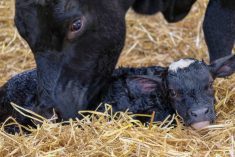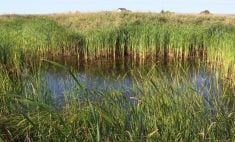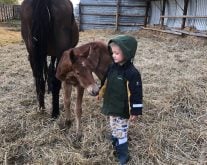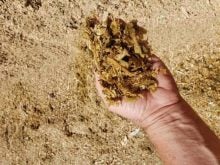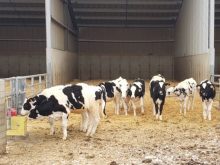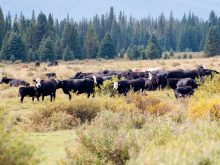Top-performing dairy cows must have healthy hooves. Walking and standing on four good hooves is the foundation of eating lots of well-balanced feed and then producing lots of milk. It is also a prerequisite for good standing heats, which leads to successful pregnancy. On the other hand, lame cows have a painful time getting out of their stalls to going over to the milking parlour or robot station.
Fortunately, most lameness in dairy cows is preventable with a well-thought-out plan that should be implemented in every barn.
Read Also

Harvest wraps up and fall work begins
At the Eppich famly ranch in western Saskatchewan, the fall harvest was successful with few breakdowns, cows and calves have been sorted and a new tractor has arrived
A good lameness-prevention plan starts with a basic understanding of what a set of four healthy hooves is all about. The illustration of the cross-section of the cow’s foot shows it is comprised of several interlocking parts: on the outside, a horny hoof wall, sole, heel, and white line (a junction between the sole and the hoof wall on the underside of the hoof). Inside the hoof or claw, the pedal bone sits inside the laminar corium, which is a nerve and blood-enriched living tissue that sit along the horn wall. This laminar corium produces the healthy nail of the hoof.
Laminitis is the inflammation of this laminar corium, which research surveys say accounts for about 80 per cent of all treated cases of lameness. Damage to this living tissue leads to abnormal horn growth and is responsible for causing great pain. It also predisposes the limping dairy cow to other hoof problems such as a breakdown of inner hoof tissues observed in sole ulcers and hemorrhages in the sole and hoof walls. It also often allows disease to enter through hoof cracks or in the white-line separation.

Proper nutrition is vital
Good cow nutrition has one of the biggest impacts on the prevention of laminitis. Feeding diets with enough effective forage-fibre has long been known to underlie strong hooves. And it follows to avoid feeding over-formulated high-grain diets, low-forage diets or finely chopped forage, all of which eventually lead to sub-acute ruminal acidosis (SARA), a primary cause of laminitis. SARA has also been implicated in greater rates of hoof wear, physical hoof injury and viral or bacterial invasion of the hoof.
As a dairy nutritionist, I have visited many farms with severe lameness problems. In one particular case, a 400-dairy cow operation had six visibly limping dairy cows standing within 20 feet of one of its many robot-milking stations.
It didn’t take me long to watch these and other cows and discover that it was caused by a lack of dietary effective-fibre, for three good reasons. They were: 1. A lack of cows lying in their stalls and chewing their cud; 2. the dry matter intake of effective forage fibre in the partial mixed ration (PMR) was inadequate compared to a large amount of robot concentrate fed; and 3. The PMR was also heavily sorted by the cows at the feed bunk.
A three-step plan
As a result, the producer could have avoided most of his limping cows’ pain and suffering if only he had taken the time to implement the following lameness-prevention plan:
- Feed enough forage effective fibre. A well-formulated dairy diet should maintain NFC levels between 33 to 38 per cent, while a minimum of 28 per cent neutral detergent fibre (NDF) should be guaranteed, with 75 per cent of this NDF coming from forage feedstuffs.
In another dairy robot barn, I struggled with achieving this advice until I balanced the PMR first and then followed through as to the type and amount of robot pellets to offer at the feeding stations. In addition, I checked the proper moisture levels (50 per cent) and particle length of the PMR to avoid sorting by dairy cows at the feed bunk.
- Implement a good dry cow feeding program. As a dairy nutritionist, I don’t believe that faraway and close-up dry cows should be fed the same diet. My ideal faraway dry cow diet should be made up of bulky good-quality forage by which the cow consumes 1.8-2.2 per cent of her bodyweight (dm basis.) And is should be followed by my close-up diet, which contains moderate-energy forage such as mixed grass hay (limiting alfalfa), and is complemented with five or six pounds of a specific grain-based close-up pellet, both of which should be mixed with limited amounts of barley or corn silage.
- Use specialized nutrition. Feed zinc methionine complex at four grams per head per day, because it is proven to strengthen hoof health. Other dietary nutrients thought to assist with healthy hooves include biotin, vitamins A and E, copper, organic iodine and selenium. Many of these nutrients are thought to play a similar role in hoof formation and integrity.
When it comes to healthy hooves, dairy cattle need all the help they can get. Just feeding the right well-balanced diet to the transition and lactating cows can prevent a lot of painful laminitis. Such preventative action should reduce the number of limping cows and, optimize the dairy’s valuable performance.




